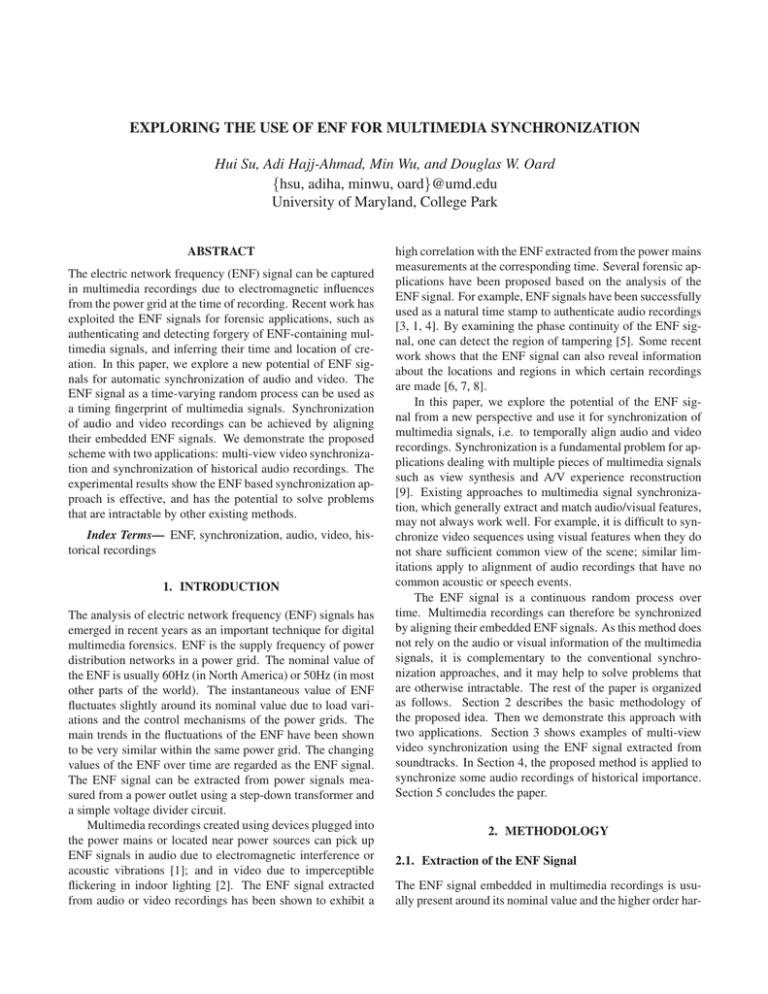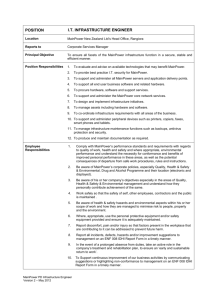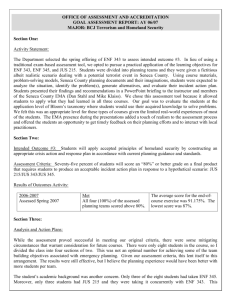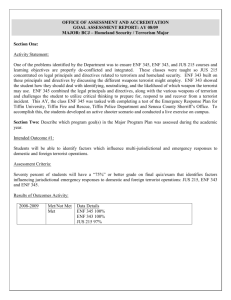EXPLORING THE USE OF ENF FOR MULTIMEDIA
advertisement

EXPLORING THE USE OF ENF FOR MULTIMEDIA SYNCHRONIZATION
Hui Su, Adi Hajj-Ahmad, Min Wu, and Douglas W. Oard
{hsu, adiha, minwu, oard}@umd.edu
University of Maryland, College Park
ABSTRACT
The electric network frequency (ENF) signal can be captured
in multimedia recordings due to electromagnetic influences
from the power grid at the time of recording. Recent work has
exploited the ENF signals for forensic applications, such as
authenticating and detecting forgery of ENF-containing multimedia signals, and inferring their time and location of creation. In this paper, we explore a new potential of ENF signals for automatic synchronization of audio and video. The
ENF signal as a time-varying random process can be used as
a timing fingerprint of multimedia signals. Synchronization
of audio and video recordings can be achieved by aligning
their embedded ENF signals. We demonstrate the proposed
scheme with two applications: multi-view video synchronization and synchronization of historical audio recordings. The
experimental results show the ENF based synchronization approach is effective, and has the potential to solve problems
that are intractable by other existing methods.
Index Terms— ENF, synchronization, audio, video, historical recordings
1. INTRODUCTION
The analysis of electric network frequency (ENF) signals has
emerged in recent years as an important technique for digital
multimedia forensics. ENF is the supply frequency of power
distribution networks in a power grid. The nominal value of
the ENF is usually 60Hz (in North America) or 50Hz (in most
other parts of the world). The instantaneous value of ENF
fluctuates slightly around its nominal value due to load variations and the control mechanisms of the power grids. The
main trends in the fluctuations of the ENF have been shown
to be very similar within the same power grid. The changing
values of the ENF over time are regarded as the ENF signal.
The ENF signal can be extracted from power signals measured from a power outlet using a step-down transformer and
a simple voltage divider circuit.
Multimedia recordings created using devices plugged into
the power mains or located near power sources can pick up
ENF signals in audio due to electromagnetic interference or
acoustic vibrations [1]; and in video due to imperceptible
flickering in indoor lighting [2]. The ENF signal extracted
from audio or video recordings has been shown to exhibit a
high correlation with the ENF extracted from the power mains
measurements at the corresponding time. Several forensic applications have been proposed based on the analysis of the
ENF signal. For example, ENF signals have been successfully
used as a natural time stamp to authenticate audio recordings
[3, 1, 4]. By examining the phase continuity of the ENF signal, one can detect the region of tampering [5]. Some recent
work shows that the ENF signal can also reveal information
about the locations and regions in which certain recordings
are made [6, 7, 8].
In this paper, we explore the potential of the ENF signal from a new perspective and use it for synchronization of
multimedia signals, i.e. to temporally align audio and video
recordings. Synchronization is a fundamental problem for applications dealing with multiple pieces of multimedia signals
such as view synthesis and A/V experience reconstruction
[9]. Existing approaches to multimedia signal synchronization, which generally extract and match audio/visual features,
may not always work well. For example, it is difficult to synchronize video sequences using visual features when they do
not share sufficient common view of the scene; similar limitations apply to alignment of audio recordings that have no
common acoustic or speech events.
The ENF signal is a continuous random process over
time. Multimedia recordings can therefore be synchronized
by aligning their embedded ENF signals. As this method does
not rely on the audio or visual information of the multimedia
signals, it is complementary to the conventional synchronization approaches, and it may help to solve problems that
are otherwise intractable. The rest of the paper is organized
as follows. Section 2 describes the basic methodology of
the proposed idea. Then we demonstrate this approach with
two applications. Section 3 shows examples of multi-view
video synchronization using the ENF signal extracted from
soundtracks. In Section 4, the proposed method is applied to
synchronize some audio recordings of historical importance.
Section 5 concludes the paper.
2. METHODOLOGY
2.1. Extraction of the ENF Signal
The ENF signal embedded in multimedia recordings is usually present around its nominal value and the higher order har-
monics. In Fig.1 (a) and (b) of the spectrograms of an audio
signal and the power mains measurement signal recorded at
the same time, we observe a strip of time-varying energy at
120 Hz and 60 Hz, respectively, which correspond to the ENF
signals in these recordings. We can extract the ENF signal by
estimating the instantaneous peak frequency among a small
range (±∆f ) around the ENF nominal value and harmonics.
Comparisons of various frequency estimation approaches for
ENF were carried out in [8, 10]. The weighted energy method
[2] is adopted here for its robustness and low complexity. The
recording signals are divided into frames of certain length
(e.g, 8 seconds), and FFT is calculated for every frame. The
ENF signal is then estimated by:
F (n) =
PL2
l=L1 f (n, l)|s(n, l)|
,
PL2
l=L1 |s(n, l)|
(1)
where fs and NF F T are the sampling frequency of the signal and the number of F F T points, respectively; L1 =
(fEN F −∆f )NF F T
)NF F T
and L2 = (fEN F +∆f
; f (n, l) and
fs
fs
s(n, l) are the frequency and energy in the lth frequency
bin of the nth time frame, respectively. Fig.1 (c) and (d)
show the ENF signals estimated from the audio recording and
the concurrent power signal, and the two have very similar
fluctuation trends.
(a) Spectrogram of an audio signal at 2nd
harmonic (120 Hz).
(b) Spectrogram of the corresponding
power signal at 60 Hz.
2.2. Synchronization using ENF
The value of the ENF fluctuates around its nominal value due
to varying supply and loads over the power grids. The major trends of these fluctuations are consistent at all locations
across the same grid. Previous work has exploited the property of the ENF traces embedded in multimedia recordings for
digital forensic purposes. In this paper, we explore the utilization of the ENF signals in multimedia recordings from a new
perspective. In viewing the ENF signal as a continuous-time
random process, its realization in each recording may serve
as a timing fingerprint. Synchronization of audio and video
recordings can therefore be performed by matching and aligning their embedded ENF signals. This is a very different approach to tackling the audio/video synchronization problem
from existing work, and has several advantages over conventional methods. The ENF based method does not reply on
having common audio and visual contents between the multiple recordings to be synchronized. Taking video synchronization for example, the conventional approaches based on visual
cues do not work well in situations where there are arbitrary
camera motions or the view overlap is insufficient, while the
ENF based method is not affected by these adverse conditions. Additionally, extracting and aligning ENF signals may
be more effective computationally than the approaches that
rely on computer vision and/or extensive learning, and thus
more (or longer) recordings could be efficiently processed. It
can also be easily generalized to synchronize multiple pieces
of recordings.
There are several requirements for the ENF based synchronization approach to work. The ENF traces in the audio
and video recordings must be strong enough so that reliable
ENF signals can be estimated. The temporal overlap between
recordings to be synchronized should be sufficiently large to
ensure accurate alignment of the ENF signals. These requirements may not be always satisfied. In our experiments, we
find the proposed method can work well in diverse settings.
In the following sections, we demonstrate the performance
of the ENF based synchronization with audio-video files and
historical audio recordings.
60.03
120.05
120.04
60.02
Frequency (in Hz)
120.03
Frequency (in Hz)
120.02
120.01
120
119.99
119.98
119.97
3. ENF FOR VIDEO SYNCHRONIZATION
60.01
60
59.99
59.98
119.96
119.95
0
500
1000
1500
Time (in seconds)
(c) ENF signal estimated from the audio
signal.
59.97
0
500
1000
Time (in seconds)
1500
(d) ENF signal estimated from the power
signal.
Fig. 1. Spectrograms and ENF estimates from audio and power
signals recorded at the same time.
In this section, we discuss in details how the ENF traces embedded in video soundtracks can be used for video synchronization. After taking the soundtracks from two video recordings to be synchronized, we first divide each soundtrack into
overlapping frames of length Lf rame seconds. The overlap
between adjacent frames is denoted as Loverlap in seconds.
So the shift from one frame to the next is Lshif t = Lf rame −
Loverlap . For every frame, we estimate the dominant frequency around the nominal value of the ENF. The values of
the estimated frequency are concatenated together to form the
ENF signal of each soundtrack. The normalized cross corre-
lation coefficients are calculated with different lags between
the ENF signals. The lag corresponding to the maximum correlation coefficients is identified as the temporal shift between
the two videos.
The accuracy of synchronization is important for many
applications involving multiple videos. Experiments are conducted to examine the accuracy of the proposed method. We
take multiple video clips simultaneously with two different
cameras at different locations, including offices, hallways,
recreation centers and lobbies. These videos are divided into
segments of 10 minutes long and each segment is treated as
a test sample. The soundtracks of the segments are analyzed
and the ENF signals are extracted from them for synchronization. The ground truth of the lag between the recordings was
obtained by manually comparing the video frames, and used
to measure the synchronization accuracy in terms of mean
absolute error (MAE) and root mean square error (RMSE)
under different settings of Lf rame and Lshif t . The experimental results are listed in Table 1 and 2. We first fix Lshif t
as 1 second and test different values of frame length Lf rame .
The alignment accuracy becomes better when Lf rame is increased, and becomes saturated at the frame length of 16
seconds or longer. Next, Lf rame is fixed as 16 seconds, and
Lshif t is varied from 1 second down to 0.1 second. The synchronization accuracy improves as we use a smaller Lshif t .
With Lf rame = 16, Lshif t = 0.1, the MAE is about 0.12
second, equivalent to 3.6 frames for videos of 30 frames /
second.
Fig. 2 shows an example of video synchronization using
the proposed approach. We use two cameras to video tape
a racket ball court from two different angles. Fig. 2 (a) is
the correlation coefficients between the ENF signals extracted
from the two video soundtracks. A significant peak is found
at the lag of around 24 seconds. The ENF signals from the
two video recordings after alignment and the ENF measured
from the power mains at the corresponding time are plotted in
Fig. 2 (b). We observe the variation patterns of these signals
match well with each other. Several video frame pairs after
alignment are shown in Fig. 2 (c).
120.14
0.8
120.12
ENF signal estimated form video 1
ENF signal estimated from video 2
0.6
Frequency (Hz)
Table 2. Synchronization accuracy with fixed Lf rame of 16
seconds and varying Lshif t
Lshif t (sec.)
1
0.5
0.3
0.1
RM SE (sec.) 0.33
0.21
0.17
0.15
M AE (sec.)
0.272 0.166 0.136 0.117
1
Grondtruth ENF measured from power mains
Correlation
Table 1. Synchronization accuracy with fixed Lshif t of 1
second and varying Lf rame
Lf rame (sec.)
8
16
24
32
RM SE (sec.) 0.79 0.33 0.32 0.33
M AE (sec.)
0.46 0.27 0.27 0.27
0.4
0.2
0
120.1
120.08
120.06
120.04
120.02
−0.2
120
−0.4
−300
−200
−100
0
100
Lag (seconds)
200
300
119.98
0
100
200
300
400
500
600
Time (seconds)
(a)
(b)
(c)
Fig. 2. Example of video synchronization by aligning the ENF signals.
4. ENF FOR SYNCHRONIZING HISTORICAL
RECORDINGS
Although most demonstrations of ENF being picked up by
digital audio and video recordings in areas of electrical activities were reported in the recent decade, the presence of ENF
can be found in analog recordings made throughout the second half of the 20th century. For example, in our recent work,
we demonstrated that ENF traces can be found in digitized
versions of 1960s phone conversation recordings of President
Kennedy in the White House [11]. Using ENF to analyze
historical recordings can have many useful applications for
forensics and archivists. For instance, many 20th century
recordings are important cultural heritage records, but some
lack necessary metadata, such as the date and time of recording. Also, the need may arise to timestamp old recordings
for investigative purposes, and ENF may provide a way to do
that.
In this section, we explore aligning historical recordings
temporally. We analyze two recordings from the 1970 NASA
Apollo 13 mission [12] that we know were recorded at approximately the same time. The first recording is from the
PAO (Public Affairs Afficer) loop, which is the space-to-
60.08
1
Average Correlation Coefficient
ENF2 + 0.05Hz
Frequency (Hz)
60.06
60.04
60.02
60
59.98
ENF1
0.8
0.6
0.4
0.2
0
−0.2
59.96
0
(a)
200
400
600 800
Time (seconds)
1000
1200
−300
−200
−100
0
100
Lag (seconds)
(a)
200
300
(b)
Fig. 4. Synchronize the Apollo 13 mission recordings with the ENF
signals.
(b)
Fig. 3. Spectrogram strips around the ENF harmonics for the Apollo
13 recordings. (a): PAO recording; (b): GOSS recording.
ground communications that was broadcast to the media. The
second recording is of GOSS Net 1 (Ground Operational Support System), which is the recording of the space-to-ground
audio as the people in mission control heard it. Both recordings are around four hours long. Figure 3 shows spectrogram
strips for both recordings about the ENF harmonics. We can
see that for the first recording, the ENF clearly appears around
all the harmonics, and especially strongly around 360Hz. For
the second recording, the ENF is noisier and it appears best
around 120Hz and 360Hz.
We extract the ENF of the first recording from around
360Hz. For the second recording, we use the spectrum combining technique for ENF estimation [13], where we combine the ENF traces from around 120Hz and 360Hz to arrive
at a more reliable ENF estimate. The resulting ENF signal
is still rather noisy; we clean the signal by locating outliers
and replacing them using linear interpolation from surrounding ENF values. Figure 4 (a) shows 20-minute simultaneous
ENF segments from both recordings, with the second ENF
signal displaced by 0.05Hz to be able to distinguish them and
see them separately. Visually, the two signals look very similar.
In a synchronization scenario, we would need to match
ENF segments from two or more signals with potentially different lags, and decide on the correct lag based on how similar the segments are, using the correlation coefficient as a
metric. As a proof-of-concept for the Apollo data described
above, we divide the first Apollo ENF signal into overlapping
10-min ENF segments, and for each segment, we correlate
it with equally-sized segments from the second Apollo ENF
with varying lags. Since the two signals were recorded at the
same time, this ground truth suggests that the highest correlation should be at zero lag. Figure 4 (b) shows the mean
values of the correlations achieved for different lags, and we
can clearly see that the highest correlation is achieved for zero
lag which matches the ground truth.
We can see that the techniques discussed earlier for audio and video alignment can be extended to aligning two
historical recordings of interest. This can potentially help
timestamp old recordings of unknown date of capturing.
With old recordings, we may not always have access to reference power ENF, as in the case considered here, yet we have
the potential to utilize historical recordings of known date
and time to create an ENF database to which we can compare
recordings of interest that have uncertain information about
capturing time.
5. CONCLUSION
In this work, we have explored the potential of the ENF signal for multimedia signal synchronization. The proposed approach works by extracting and aligning the ENF signals embedded in audio and video recordings. We have demonstrated
our method with two applications: multi-view video synchronization and alignment of historical audio recordings. The
ENF based synchronization approach has been shown to be
effective, and has the potential to address challenging scenarios and complement other existing methods.
Acknowledgement This work is supported in part by NSF
grants #1008117 (University of Maryland ADVANCE Seed
Research Grant), #1309623 and #1218159.
6. REFERENCES
[1] C. Grigoras, “Applications of ENF criterion in forensics:
Audio, video, computer and telecommunication analysis,”
Forensic Science International, vol. 167(2-3), pp. 136–145,
April 2007.
[2] R. Garg, A. Varna, and M. Wu, “Seeing ENF: natural time
stamp for digital video via optical sensing and signal
processing,” in 19th ACM International Conference on
Multimedia, Nov. 2011.
[3] M. Huijbregtse and Z. Geradts, “Using the ENF criterion for
determining the time of recording of short digital audio
recordings,” in International Workshop on Computational
Forensics (IWCF), Aug. 2009.
[4] R. W. Sanders, “Digital authenticity using the electric
network frequency,” in 33rd AES International Conference on
Audio Forensics, Theory and Practice, June 2008.
[5] D. Rodriguez, J. Apolinario, and L. Biscainho, “Audio
authenticity: Detecting ENF discontinuity with high precision
phase analysis,” IEEE Transactions on Information Forensics
and Security, vol. 5(3), pp. 534–543, Septemper 2010.
[6] A. Hajj-Ahmad, R. Garg, and M. Wu, “ENF based location
classification of sensor recordings,” in IEEE Int. Workshop on
Info. Forensics and Security (WIFS), Nov. 2013.
[7] R. Garg, A. Hajj-Ahmad, and M. Wu, “Geo-location
estimation from electrical network frequency signals,” in
IEEE Int. Conf. Acoustics, Speech, and Signal Processing
(ICASSP), May 2013.
[8] A. Hajj-Ahmad, R. Garg, and M. Wu, “Instantaneous
frequency estimation and localization for ENF signals,” in
APSIPA Annual Summit and Conference, Dec. 2012.
[9] “The first men on the moon: The apollo 11 lunar landing,”
http://www.firstmenonthemoon.com/.
[10] O. Ojowu, J. Karlsson, J. Li, and Y. Liu, “ENF extraction from
digital recordings using adaptive techniques and frequency
tracking,” IEEE Transactions on Information Forensics and
Security, vol. 7(4), pp. 1330–1338, August 2012.
[11] H. Su, R. Garg, A. Hajj-Ahmad, and M. Wu, “ENF analysis
on recaptured audio recordings,” in IEEE Int. Conf. Acoustics,
Speech, and Signal Processing (ICASSP), May 2013.
[12] “Apollo 13 audio recordings,”
https://archive.org/details/Apollo13Audio.
[13] A. Hajj-Ahmad, R. Garg, and M. Wu, “Spectrum combining
for ENF signal estimation,” IEEE Signal Processing Letters,
vol. 20(9), pp. 885–888, September 2013.




